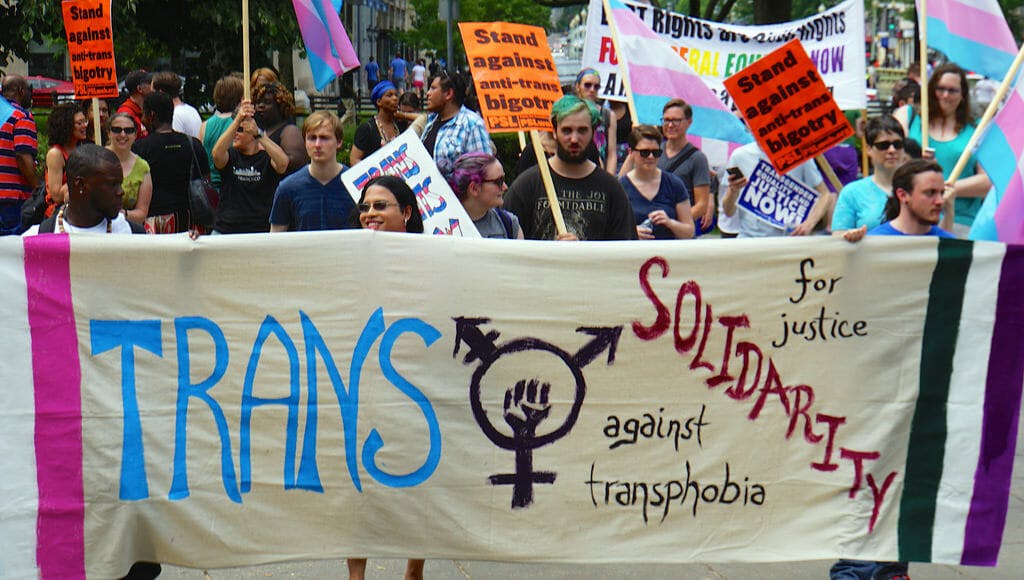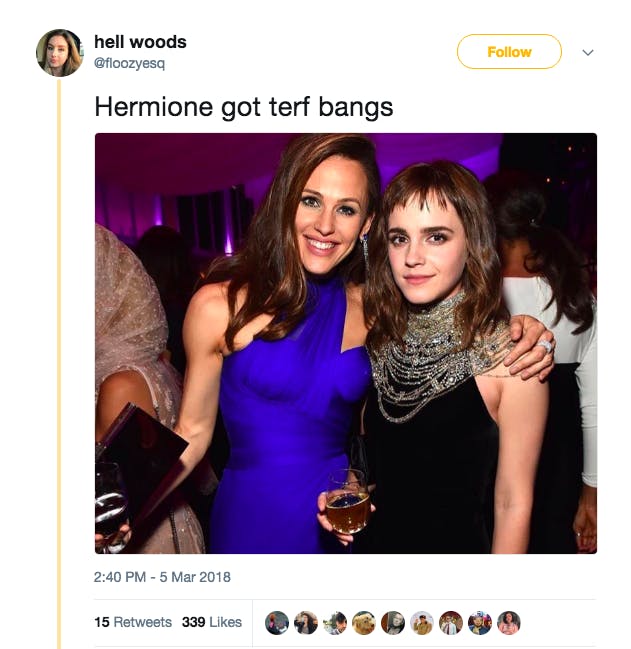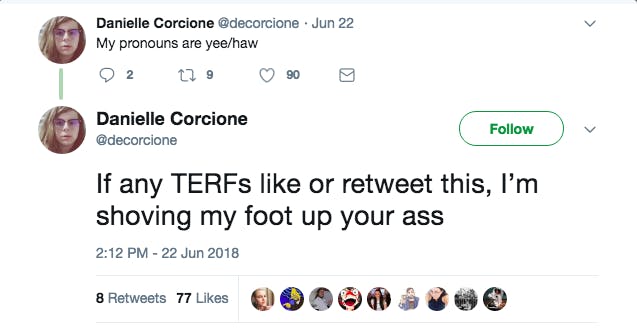This article addresses transphobic ideas and may be triggering to some readers.
Scrolling through your social feeds in the recent years, you may have noticed a new acronym: TERF, or “trans-exclusionary radical feminist.” Originally coined in 2008, its popularity has mounted in tandem with both feminism and transgender acceptance and gained fringe traction via social media before rising into general use. Although TERF’s meaning is in its name, most people don’t know the specifics of what TERFs believe or want. You may only know that they are feminists who exclude trans people.
Not unlike the various “family values” organizations that emerged as a response to LGBTQ rights in the last decade, TERF feminism claims to protect innocent people who would supposedly be hurt by the acceptance of a marginalized group.
They claim to represent “real women” and say that mainstream feminism has abandoned its foundations. TERF opponents say TERFs are clinging to sexist definitions of womanhood and are propagating transphobia. With such vastly different descriptions, it can be hard for an average person to discern which information is accurate. Here is everything you need to know about TERFs and trans-exclusionary radical feminism.
What is a TERF?
The term “trans-exclusionary radical feminism” is in some ways self-explanatory. However, the term alone doesn’t explain the reasons behind the beliefs, or where this sect of radical feminism falls within the wider feminist umbrella. The Trans Advocate defines TERFs as “individuals who sympathize with and support a brand of ‘radical feminism’ that is so rooted in sex essentialism and its resulting biologism, it actively campaigns against the existence, equality, and/or inclusion of trans people.”
Similar to many in the religious right, TERFs believe that gender and sex are the same. They believe that transitioning gender is not possible. Through the lens of sex essentialism, they see trans people (depending on the sex they were assigned at birth) as either victims or pushers of a dangerous movement against women.
In 2017, Megan Murphy penned an article for the Feminist Current titled “‘TERF’ isn’t just a slur, it’s hate speech” wherein she says that one of the foundational ideas of feminism is “understanding that the root of women’s oppression and male supremacy is in biological sex.”
“Patriarchy began as a means to control women’s reproductive capacity,” Murphy writes. “Therefore, women’s biology is very much central to their status as ‘less than.’” This ideology is based on the idea that, because of how patriarchy began, people are born into classes of oppressed or oppressor based on their reproductive organs. This foundation informs the TERF view that trans men are merely trying to escape the weight of the patriarchy and that trans women do not belong in “women-only” spaces. According to this conception of gender, a person who was not born with organs like a uterus or ovaries—even if she had lived as a woman her whole life—would not be a woman because of biology.

Is TERF a slur?
Like Murphy, many trans-exclusionary feminists argue that the term “TERF” is a slur, created to silence women. “‘TERF,’ is itself an intentional manipulation, intended to reframe feminist ideas and activism as ‘exclusionary,’” Murphy writes.
But feminist linguist Deborah Cameron questions what makes a word a slur. “Does the word have a neutral counterpart which denotes the same group without conveying hatred/contempt?” Cameron writes. These questions have different answers depending on who you ask. While trans-inclusive feminists say there is not another term, trans-exclusive feminists say the neutral term is just “feminist.”
Some feminists also argue that power dynamics need to be taken into account. “Historically, derogatory terms have been labeled slurs when there are oppressive power systems (often enforced by violence) in place to back them up. The N-word is a slur because it was enforced by centuries of slavery, rape, and violence,” Everyday Feminism contributor Marina Watanabe wrote on Twitter. “There is no dominant ideology or social system in place that privileges trans people.”
Therefore, the claim that TERF was invented to silence women does not hold up to scrutiny. The earliest record of the term being used is in a Finally, a Feminism 101 Blog post from 2008, written by a feminist cisgender woman.
READ MORE:
- The dirty, complex, empowering history of the word ‘queer’
- What it means to be transgender
- How big is the transgender population, really?
- Breaking down the difference between gender identity and sex
What do TERF politics look like?
Like any political faction, trans-exclusionary feminists don’t agree on everything. The most often-stated goal is to “keep women’s spaces for women” (by which they mean cisgender women), but some also advocate against transgender rights in general.
Perhaps the most visible demonstration of TERF ideology happened at London Pride this year, when a group called “Get the L Out” reportedly “forced” their way to the front of the parade. They held signs that said things like “lesbian = female homosexual.” They also were handing out flyers which claimed, among other things, that the transgender movement is upholding sexist stereotypes, and manipulating lesbians into becoming trans men.
Many trans-exclusionary feminists ally themselves with conservatives on so-called “bathroom bills” in an attempt to keep trans women out of any and all women’s spaces. They have been active in advocating against legal protections based on gender identity and gender expression, including writing a letter to the U.N. about it.
Much of the fight for TERFs is a game of optics. They call their activism “gender critical” to appear as if they are questioning the ideas of gender, rather than explicitly denying people’s self-identification. Due to their frequent claims that transgender women are seeking to abuse cisgender women, much of their public communication is also focused on “proving” this claim. The idea that TERF is a slur is a part of this, allowing them to characterize a shirt that says “FUCK TERFS” as abusive hate speech. There is also an effort to mischaracterize statements or jokes as explicit and direct threats of violence, such as when they got a Teen Vogue writer banned from Twitter by reporting the following joke as a “violent threat.”
Another example is how many “gender critical” feminists reacted to trans YouTuber Riley J. Dennis saying genital preferences can be discriminatory. Petitions and articles claimed she was coercing and emotionally manipulating people into having sex, and some even went as far as to call her a rapist. Even invoking the common leftist joke of putting someone (in this case TERFs) in the gulag is characterized as advocating for violence against women.
READ MORE:
- What does cisgender mean—and what is cisgender privilege?
- Everything you have never understood about being nonbinary
- Trans and nonbinary people explain what gender dysphoria feels like
- Here’s what it really means to be asexual
How do mainstream feminists feel about TERFs?
TERFs are a small minority within feminism, and they are shrinking as gender is becoming more commonly accepted as a spectrum, rather than two distinct categories. Women’s publications like Bitch Media and mainstream sites like Salon have resolutely stood against trans-exclusionary feminism, and get the L Out was met with boos at London Pride.
Even if this sect was less vehemently opposed to transgender acceptance, it would still be left in the dust. The focus on sexed biology as the biggest determinant of whether a person is oppressed does not meld with the modern feminist understanding of intersectionality, which also considers oppression based on race, sexuality, age, disability, and class.
For many feminists, TERFs are just a remnant of second-wave feminism, but for trans people, they are a looming shadow over feminist inclusion.
Editor’s note: This article is regularly updated for relevance.



